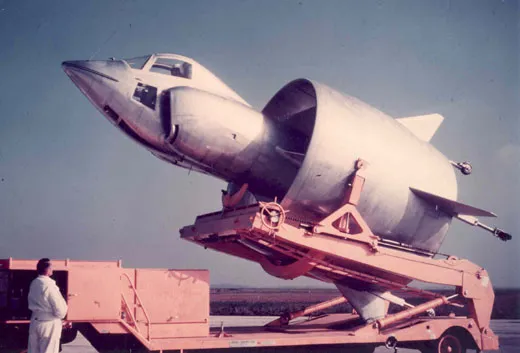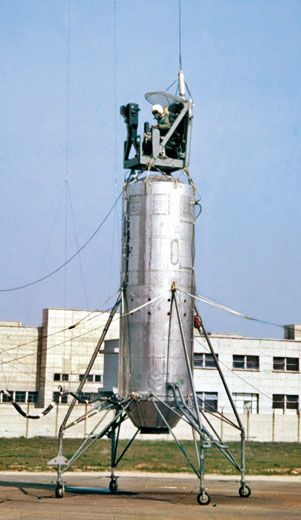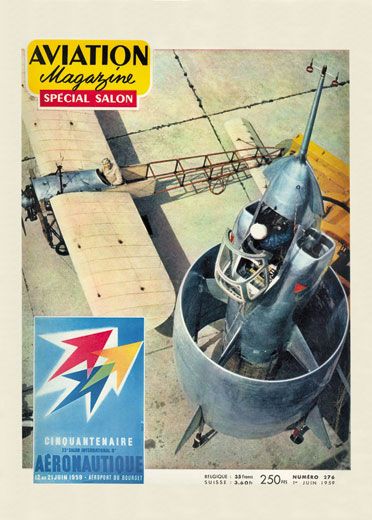Cancelled: Vertical Flyer
The Coléoptère was one weird-looking aircraft.
/https://tf-cmsv2-smithsonianmag-media.s3.amazonaws.com/filer/Beetle-C450-FLASH.jpg)
It only took forty years after the invention of flight for the world to get fed up with airports. The French magazine Docaéro complained that runways “constitute the nightmare of modern aeronautics. [I]n addition to tying up considerable tracts of land for their construction, they demand enormous amounts of time and money.”
But the future was looking up, in the form of vertical-takeoff-and-landing aircraft. Postwar strategists envisioned fighter aircraft flitting around the frontline like wasps, swooping down to attack the enemy and finding cover in nearby forests before taking off like missiles to intercept incoming bombers.
France bucked the previous style of delta-wing tail-sitters set by the Lockheed XVF, Convair XFY Pogo, and Ryan X-13Vertijet, instead pursuing a radical design conceived by Austrian engineer Helmut von Zborowski. A wing, he thought, should do more than provide lift. And an engine should do more than provide thrust. “The art of the design engineer,” he wrote in a 1955 issue of Interavia, “will therefore be to make one and the same component serve a variety of purposes.” He proposed an annular, or doughnut-shaped, wing surrounding a fuselage and serving “as power plant, airframe of a flying wing aircraft and drag-reducing housing.” By injecting fuel into the gap between wing and fuselage, Zborowski theorized, he could turn his wing into a ramjet engine, and his aircraft into a supersonic interceptor. But first he had to get it airborne.
To study the control of a hovering machine, engine builder SNECMA (Société Nationale d’Études et Construction de Moteurs d’Aviation) started in 1956 with a bare-bones prototype. The C400 P1, little more than a SNECMA Atar DV turbojet pointed skyward and mounted on four wheels, was connected to ropes and safety harnesses beneath a gantry. The test pilot was in a nearby van, peering through the bubble canopy and using a joystick-like control to fly the vehicle.
Problems surfaced immediately. The engine shook violently, sometimes cutting out radio communications between the van and the aircraft. According to Jean-Cristophe Carbonel, author of La SNECMA, von Zborowski et le Coléoptère, one engineer said the rudimentary control of the P1 was “like a bicyclist trying to keep his balance while he’s stopped.” In February 1957, engineers unveiled the C400 P2, with an instrument panel, aerodynamic controls, and fuel for four minutes of flight.
According to Carbonel’s La SNECMA, test pilot Auguste Morel, perched on an ejection seat on top of the engine, just above the inlet, recounted, “As soon as the vehicle left the ground, the vibrations disappeared and radio communication became possible.” With the P2 now hovering, but still short of achieving horizontal flight, Morel soon complained that the only way he could accurately gauge height was by listening for a change in pitch in the engine’s hum. The test team whipped up a fix in which a contact light was tripped when a string on a pebble, dangling from the side of the engine, went slack as the aircraft approached the ground. The system, often hampered by winds, was soon replaced with a more robust system named Lumisol, which measured the reflection of a light focused on the landing pad and converted the intensity into altitude.
In the spring of 1958, the C450 Coléoptère, French for “beetle,” arrived at the air field at Villaroche in northern France. Takeoff, hover, and landing were controlled by deflecting vanes in the engine exhaust: in horizontal flight by four fins mounted just above the castoring landing gear, and in the transition to vertical flight by two retractable canards in the nose.
With a full annular wing, an enclosed cockpit, and a seat that tilted forward to allow the pilot a nearly upright position during hover, the Coléoptère soon attained celebrity status. Catherinettes—French bachelorettes who annually advertised their single status by wearing eccentric hats—donned papier-mâché Coléoptères. The vehicle soon showed up on the pages of the comic book magazine Tintin, where it figured prominently in the Dan Cooper adventure, “The Silent Barrier.” Coléoptère fever soon spread to America, prompting the Navy to enlist Kaman Aircraft, a helicopter builder, to design an annular-wing vehicle nicknamed the Flying Barrel.
But problems persisted. Without the benefit of a large delta wing to dampen any rolling tendency during hover, the Coléoptère had the tendency to slowly spin about its vertical axis. Instrumentation also was spotty. On one flight, Morel called the vertical speed indicator “a fantasy” and complained of “an unacceptable imprecision in steering” during landing. Still, free flights often reached altitudes of several hundred feet.
The Coléoptère briefly and unexpectedly achieved horizontal flight only on its ninth and last foray, when the aircraft yawed during a powered descent that degenerated into wild oscillations—including a brief horizontal acceleration– preventing Morel’s ejection until just 160 feet above the ground. The aircraft burned, and Morel was badly injured. The June 14, 1957 issue of Flight magazine had tactfully summed up the Coléoptère program at its midway point: “It is…possible to visualize point-defense functions for which the endurance of such a machine (five minutes at full power) would be adequate. In this context it is worth pointing out that dead-stick landings are impossible.”
Writer and aeronautical engineer Jeremy Davis lives in Indianapolis.



